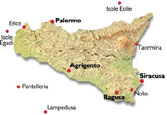 |
 |
|
Agrigento | ||
|
||||||||
|
Akragas to the Greeks, Agrigentum to the Romans, Kerkent to the Arabs, Girgenti in the Middle Ages, and finally back to Agrigento on Mussolini's orders. A fragment of Pindar (119) praises Theron under whose rule Akragas reached its acme of prosperity - he and his son-in-law Gelon, tyrant of Syracuse defeated the Carthaginians at Himera in 480 BC (the same year that their compatriots in mainland Greece were beating back the Persians) - and who crowned his career with a victory in the chariot race at the Olympic Games in 476 BC:
Starting from the east, then: the Temple of Hera is a romantic ruin, dating from about 450 BC. The Temple of Concord (so-called: there's no evidence for its dedication) is the best preserved Greek temple anywhere: only the Hephaisteion in Athens can be compared (and is roughly contemporary with it - around 440 BC). Originally the honey-coloured sandstone would have been covered with stucco made with marble dust, to make it look more like a "proper" temple. We can be grateful to the splendidly-named Gregory of the Turnips (S. Gregorio delle Rape) Bishop of Agrigento for its excellent preservation: he turned it into a Christian church in the 6th century AD.
The Temple of Heracles is a ruin whose columns were re-erected in the 1920s; it's the oldest of the temples, and was originally mauch larger than the two already visited. Its main claim to fame is that it was from here that Verres attempted to steal the statue of Heracles in 73 BC: according to Cicero, the townspeople found out about his plot and stoned the soldiers he'd sent to remove it, thus saving it - which they'd been unable to do with the famous staute of Apollo (by Myron, no less) which Verres had already stolen from the Temple of Asclepius. (This was the second time it had been stolen - the Carthaginians had removed it in the sack of the city in 406 BC, and it had been brought back by Scipio Aemilianus in 146 BC.)
The Temple of Castor and Pollux is a nonsense - assembled from various sources in the early 19th century; this has not stopped it adorning numerous posters as a symbol of ancient Sicily! In fact there were several temples in this area - among which were those originally in the Sanctuary of the Chthonic Deities (Dionysus, Demeter and Persephone/Kore). These were probably the earliest buildings on the site
A visit to the Museo Nazionale Archeologico is essential - it's a very fine one, even by Sicilian standards, which are extremely high (as you'll know if you've already visited Syracuse and Gela). Opposite the museum are extensive remains of the Hellenistic city - all to be absorbed before you climb up the hill to the modern/medieval city! The prize exhibit is the Telamon, but there are some wonderful red-figure vases (including pots by the Pan Painter, the Edinburgh Painter and the Leningrad Painter; the best is a massive volute crater depicting an Amazonomachia - including Penthesilea -, with a Centauromachia round the rim) and much else, all superbly arranged. From March 2006, visitors can have a robot as their guide. The robot - an innovation in museum technology - can navigate the museum smoothly without bumping into things, and deliver an enthusiastic commentary, which will eventually be available in languages besides Italian. Story here.
Two great men came from Agrigento - Empedocles (who has unknowingly donated his name to the unwholesome Porto Empedocle which you can see from the Valle), the magician/philosopher (c.492 - 432 BC) who first postulated the four elements - earth, air, fire and water, and who allegedly died while exploring the crater of Mount Etna; and Luigi Pirandello (1867 - 1936) prolific author of Sei personaggi in cerca d' autore (Six persons in search of an author), written in 1921, and winner of the Nobel Prize for literature. His birthplace at Caos is now a small museum, and is worth a visit
|
 |
Use the table below to find your way around Sicily: |  |
||||||||||
| Map | Index | PA | ME | CT | EN | CL | SR | RG | AG | TP | ||
Printer friendly page: click to print
| What's new? | Search the site? | Main Index? | Bookshop? | Top of Page? | ||||
|
The Classics Pages are written and designed
by Comments, questions and contributions welcome. |
||||||||